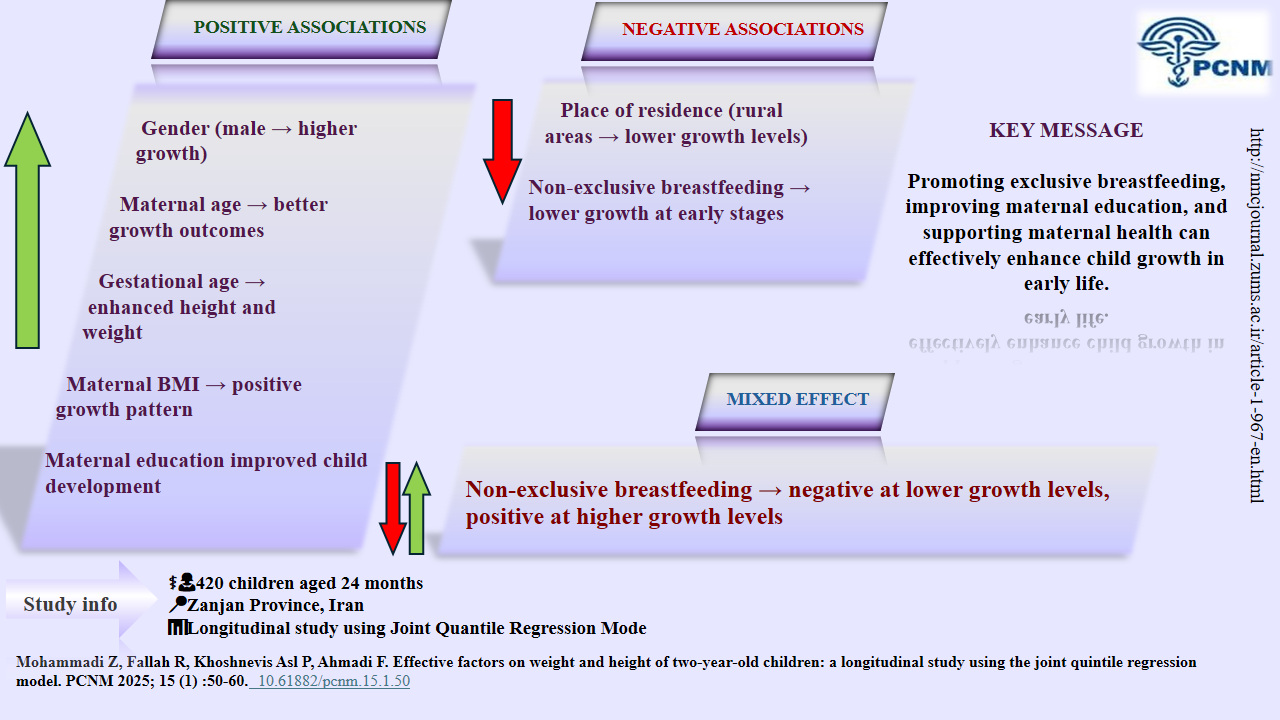
Preventive Care in Nursing and Midwifery Journal

Volume 15, Issue 1 (1-2025)
Prev Care Nurs Midwifery J 2025, 15(1): 56-65 |
Back to browse issues page
Ethics code: IR.ZUMS.REC.1401.212
Download citation:
BibTeX | RIS | EndNote | Medlars | ProCite | Reference Manager | RefWorks
Send citation to:



BibTeX | RIS | EndNote | Medlars | ProCite | Reference Manager | RefWorks
Send citation to:
Mohammadi Z, Fallah R, Khoshnevis Asl P, Ahmadi F. Effective factors on weight and height of two-year-old children: A longitudinal study using the joint quintile regression model. Prev Care Nurs Midwifery J 2025; 15 (1) :56-65
URL: http://nmcjournal.zums.ac.ir/article-1-967-en.html
URL: http://nmcjournal.zums.ac.ir/article-1-967-en.html
Department of Statistics and Epidemiology, School of Medicine, Zanjan University of Medical Sciences, Zanjan, Iran , ahmadi.farzan@gmail.com
Abstract: (326 Views)
Background: Child growth is an important indicator of health from infancy to adulthood. Height and weight are widely used to assess the physical development and health of children. Since the effects of related factors may differ across the distribution of growth, joint quintile regression provides an appropriate method to identify heterogeneous associations.
Objectives: This study aimed to identify the factors influencing growth indicators of tow-year-old children using the joint quintile regression model.
Methods: In this longitudinal study, data were obtained from health records of 420 children aged 24 months, covered by urban and rural health service centers in Zanjan province, Iran, in 2019, using two-stage cluster sampling. The joint quintile regression model was fitted by R 4.3.3.
Results: The majority of children in the study were male (52.1%), urban residents (71.4%), and had mothers with diploma education (30.0%). The mean (SD) age of mothers was 30.70 (6.44) years. In all quintiles, gender, maternal age, gestational age (GA), maternal body mass index, and maternal education were positively and significantly associated with children's height and weight, except for maternal diploma education at the 0.25 quintile [95% CI (-0.05,0.03)]. Place of residence was negatively and significantly associated with both outcomes. Also, non-exclusive breastfeeding was negatively associated with children's height and weight at lower quintiles and positively associated at higher quantizes.
Conclusion: Considering the factors affecting child growth, paying attention to (gestational age, maternal education, place of residence, and exclusive breastfeeding) can be effective in promoting child growth.
Objectives: This study aimed to identify the factors influencing growth indicators of tow-year-old children using the joint quintile regression model.
Methods: In this longitudinal study, data were obtained from health records of 420 children aged 24 months, covered by urban and rural health service centers in Zanjan province, Iran, in 2019, using two-stage cluster sampling. The joint quintile regression model was fitted by R 4.3.3.
Results: The majority of children in the study were male (52.1%), urban residents (71.4%), and had mothers with diploma education (30.0%). The mean (SD) age of mothers was 30.70 (6.44) years. In all quintiles, gender, maternal age, gestational age (GA), maternal body mass index, and maternal education were positively and significantly associated with children's height and weight, except for maternal diploma education at the 0.25 quintile [95% CI (-0.05,0.03)]. Place of residence was negatively and significantly associated with both outcomes. Also, non-exclusive breastfeeding was negatively associated with children's height and weight at lower quintiles and positively associated at higher quantizes.
Conclusion: Considering the factors affecting child growth, paying attention to (gestational age, maternal education, place of residence, and exclusive breastfeeding) can be effective in promoting child growth.
Full-Text [PDF 932 kb]
(210 Downloads)
| | Full-Text (HTML) (22 Views)


Knowledge Translation Statement
Audience: Pediatric nurses and community health planners.
Maternal education, gestational age, and rural residence significantly impact child growth. Target rural and less-educated mothers with growth monitoring, breastfeeding support, and prenatal care education.
Audience: Pediatric nurses and community health planners.
Maternal education, gestational age, and rural residence significantly impact child growth. Target rural and less-educated mothers with growth monitoring, breastfeeding support, and prenatal care education.
Type of Study: Orginal research |
Subject:
other
References
1. Moradi Y, Shadmani FK, Mansori K, Hanis SM, Khateri R, Mirzaei H. Prevalence of underweight and wasting in Iranian children aged below 5 years: a systematic review and meta-analysis. Korean Journal of Pediatrics. 2018;61(8):231. [https://doi.org/10.3345/kjp.2018.61.8.231] [PMID]
2. De Onis M. Child growth and development. Nutrition and Health in a Developing World. 2017:119-41. [https://doi.org/10.1007/978-3-319-43739-2_6]
3. Ngwira A, Munthali EC, Vwalika KD. Analysis on the association among stunting, wasting and underweight in Malawi: an application of a log-linear model for the three-way table. Journal of Public Health in Africa. 2017;8(1):620. [https://doi.org/10.4081/jphia.2017.620] [PMID]
4. Bekele T, Rahman B, Rawstorne P. The effect of access to water, sanitation and handwashing facilities on child growth indicators: Evidence from the Ethiopia Demographic and Health Survey 2016. PLOS One. 2020;15(9):e0239313. [https://doi.org/10.1371/journal.pone.0239313] [PMID]
5. Hägglund G, Andersson S, Düppe H, Pedertsen HL, Nordmark E, Westbom L. Prevention of severe contractures might replace multilevel surgery in cerebral palsy: results of a population-based health care programme and new techniques to reduce spasticity. Journal of Pediatric Orthopaedics B. 2005;14(4):269-73. [https://doi.org/10.1097/01202412-200507000-00007] [PMID]
6. Pourali S, Khorshodian N, Avazpour M, Malekzadeh J. An analytical study of complementary feeding pattern among healthy and failure to thrive children in Boyer-Ahmad County: A matched case-control study. Armaghane-Danesh. 2021;26(5):815-26. [https://doi.org/10.52547/armaghanj.26.5.815]
7. Titaley CR, Ariawan I, Hapsari D, Muasyaroh A, Dibley MJ. Determinants of the stunting of children under two years old in Indonesia: A multilevel analysis of the 2013 Indonesia basic health survey. Nutrients. 2019;11(5):1106. [https://doi.org/10.3390/nu11051106] [PMID]
8. Barker DJ, Osmond C, Kajantie E, Eriksson JG. Growth and chronic disease: findings in the Helsinki Birth Cohort. Annals of Human Biology. 2009;36(5):445-58. [https://doi.org/10.1080/03014460902980295] [PMID]
9. Beal T, Tumilowicz A, Sutrisna A, Izwardy D, Neufeld LM. A review of child stunting determinants in Indonesia. Maternal and Child Nutrition. 2018;14(4):e12617. [https://doi.org/10.1111/mcn.12617] [PMID]
10. Alfo M, Marino MF, Ranalli MG, Salvati N, Tzavidis N. M-quantile regression for multivariate longitudinal data: analysis of the Millennium Cohort Study data. ArXiv Preprint. 2016;1612.08114. [https://doi.org/10.48550/arXiv.1612.08114]
11. Kulkarni H, Biswas J, Das K. A joint quantile regression model for multiple longitudinal outcomes. ASTA Advances in Statistical Analysis. 2019;103:453-73. [https://doi.org/10.1007/s10182-018-00339-9]
12. Staffa SJ, Kohane DS, Zurakowski D. Quantile regression and its applications: a primer for anesthesiologists. Anesthesia and Analgesia. 2019;128(4):820-30. [https://doi.org/10.1213/ANE.0000000000004017] [PMID]
13. Nurrizka RH, Wenny DM, Amalia R. Complementary feeding practices and influencing factors among children under 2 years of age: a cross-sectional study in Indonesia. Pediatric Gastroenterology, Hepatology and Nutrition. 2021;24(6):535. [https://doi.org/10.5223/pghn.2021.24.6.535] [PMID]
14. Al-Mazrou Y, Al-Amood MM, Khoja T, Al-Turki K, El-Gizouli SE, Tantawi N, et al. Standardized national growth chart of 0-5 year-old Saudi children. Journal of Tropical Pediatrics. 2000;46(4):212-7. [https://doi.org/10.1093/tropej/46.4.212] [PMID]
15. Atarodi F, Mousavinasab N, Zamanfar D, Fallah R, Moadikhah S, Moadikhah S. Unraveling growth: analyzing the key factors influencing growth rate of children under two years. Journal of Biostatistics and Epidemiology. 2024. [https://doi.org/10.18502/jbe.v10i4.18523]
16. Vahabi N, Zayeri F, Moghadam EF, Safari M, Ebrahimzadeh F. Assessing the factors affecting height and weight trends among children under two years of age in Khorramabad: an application of marginal modeling. Iranian Journal of Epidemiology. 2015;11. [https://sid.ir/paper/120693/en]
17. Gohari MR, Zaeri F, Moghdamifard Z, Kholdi N, Vahabi N. Application of random effect model for determining factors affecting FTT in less than 2 years children in east of Tehran. Razi Journal of Medical Sciences. 2012:32-9. [http://rjms.iums.ac.ir/article-1-2201-fa.html.]
18. Mohammadbeigi A, Bayati A, Masoumi N, Soltani M. Effect of maternal breastfeeding on growth pattern of less than 6 month sucklings. Journal of Jahrom University of Medical Sciences. 2022;7(1):37-44. [https://doi.org/10.29252/jmj.7.1.2.37]
19. Ebrahimzadeh FH, Shadmehr A, Vahabi N, Fazeli Moghadam E, Naserian J, Safari M. Application of a marginal model for assessing some determinants of height and weight growth among children less than two years old in Khorramabad. Arak Medical University Journal. 2016;18(10). [http://jams.arakmu.ac.ir/article-1-3629-en.html.]
20. Rezaeizadeh G, Mansournia MA, Keshtkar A, Farahani Z, Zarepour F, Sharafkhah M, et al. Maternal education and its influence on child growth and nutritional status during the first two years of life: a systematic review and meta-analysis. EClinicalMedicine. 2024;71. [https://doi.org/10.1016/j.eclinm.2024.102574] [PMID]
21. Manoochehri S, Faradmal J, Poorolajal J, Asadi FT, Soltanian AR. Risk factors associated with underweight in children aged one to two years: a longitudinal study. BMC Public Health. 2024;24(1):1875. [https://doi.org/10.1186/s12889-024-19147-9] [PMID]
22. Hjertholm KG, Iversen PO, Holmboe-Ottesen G, Jepsen R. Risk factors for undernutrition and poor growth during the first 6 months of life in sub-Saharan Africa: a scoping review. Clinical Nutrition ESPEN. 2025. [https://doi.org/10.1016/j.clnesp.2025.05.019] [PMID]
23. Yu SH, Mason J, Crum J, Cappa C, Hotchkiss DR. Differential effects of young maternal age on child growth. Global Health Action. 2016;9(1):31171. [https://doi.org/10.3402/gha.v9.31171] [PMID]
24. Hosseinzadeh Z, Jashni Motlagh A, Biglarian A. Application of quantile regression to identify risk factors in infant growth parameters, private and social security hospitals in Tehran. Razi Journal of Medical Sciences. 2018;24(165):85-95. [https://sid.ir/paper/11059/fa.]
25. Hokken-Koelega AC, van der Steen M, Boguszewski MC, Cianfarani S, Dahlgren J, Horikawa R, et al. International consensus guideline on small for gestational age: etiology and management from infancy to early adulthood. Endocrine Reviews. 2023;44(3):539-65. [https://doi.org/10.1210/endrev/bnad002] [PMID]
26. Hochstedler KA, Bell G, Park H, Ghassabian A, Bell EM, Sundaram R, et al. Gestational age at birth and risk of developmental delay: the Upstate KIDS study. American Journal of Perinatology. 2021;38(10):1088-95. [https://doi.org/10.1055/s-0040-1702937] [PMID]
27. Shahsavari S, Zayeri F, Roshani D. Application of transition and marginalized transition longitudinal models for determining factors affecting FTT in children under 2 years in Tarom. Daneshvar Medicine. 2017;25(1):31-8.
28. Manoochehri S, Manoochehri Z, Asadi FT, Soltanian AR. A multilevel analysis of factors associated with wasting in children one to two years old in Hamadan city. Scientific Reports. 2024;14(1):28553. [https://doi.org/10.1038/s41598-024-75535-6] [PMID]
29. Ahmadi N, Salarilak S, Karamiar M, Khalkhali H. Survey of risk factors for failure to thrive among children less than one year age in Salmas district. Urmia Medical Journal. 2012. [http://umj.umsu.ac.ir/article-1-1175-en.html]
Send email to the article author
| Rights and permissions | |
 |
This work is licensed under a Creative Commons Attribution-NonCommercial 4.0 International License. |




